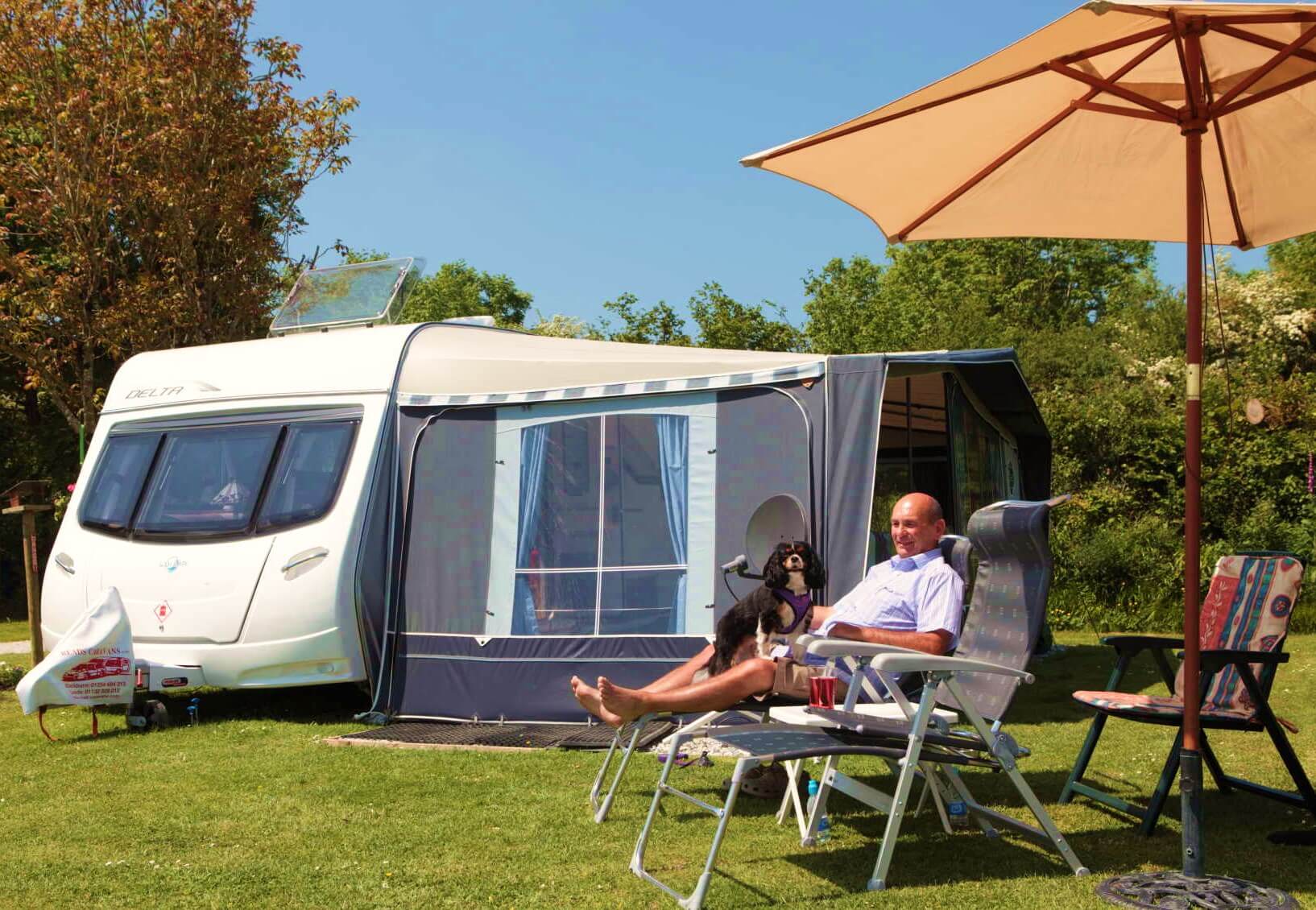PLACES TO VISIT
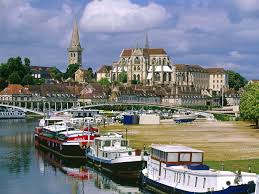
AUXERRE
The Abbey of Saint-Germain Abbey was an important center of intellectual and spiritual rebirth of Carolingian Europe, thanks to the fruitful work of the great masters of the "school Auxerre". Crypts remained the largest known of the Carolingian Renaissance testimony. Frescoes dating from the 9th century, representing the martyrdom of St. Stephen before the walls of Jerusalem, is the oldest discovered to date in France. Set on 2 floors in the former monks' dormitory of the 17th century, the museum Saint-Germain offers great local collections of prehistoric archaeological and Gallo-Roman.
Cathedral Saint-Étienne: The current Gothic building in the 13th century followed a novel built in the 11th century building. The new Romanesque church remains only the impressive crypt. We see, covered in ocher country, a rare fresco: the only known example of a Christ riding a white horse. The cathedral treasury contains, among other valuables, enamels 13th century miniatures and ancient manuscripts from the 15th and 16th centuries.
The Clock Tower: Located in the heart of the pedestrian area, the second protected area of Burgundy, surrounded by beautiful houses with wood sides, stands the Clock Tower, formerly called round Gaillarde. Flamboyant Gothic style, it was built in the 15th century on the foundations of a tower of the Gallo-Roman castrum. The clock face shows with needles original lunar and solar hours.
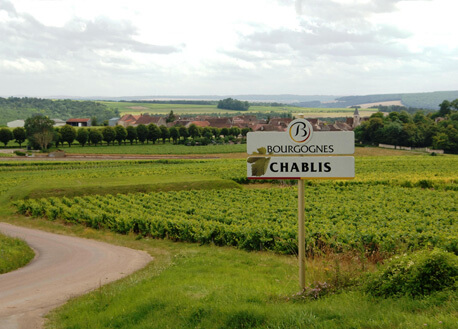
CHABLIS
With its miseries and joys, the history of Chablis resembles that of France.
The first written quote Chablis back to the year 867, when King Charles the Bald, grand-son of Charlemagne, donated the "cellam Capleiam (Chablis monastery), its churches, its houses, vineyards and deer of both sexes capita to Tours of canons. " These fleeing Normans, took refuge with the relics of St. Martin from 872 to 877. Therefore, religious settled in Chablis, planted vines and set value that already existed.
Since the Middle Ages, wine was exported to England Chablis by Rouen, to Picardy and Flanders via Compiègne.
Therefore, the village of Chablis developed the "high city" with St Peter's Church, the Hôtel-Dieu, Saint-Cosme priory and the "lower city" around the Saint-Martin collegiate church. It's the Hundred Years War which explains that at the beginning of the fifteenth century, they raised the walls of the "lower city" with 29 square towers, 3 doors and 3 posterns, known as "St. Lawrence", "On Master "and" Chenneton ".
In 1478 Peter the Red obtained the Royal Privilege to establish the fifth printing Chablis France.
1568: Black February for Chablis: the Wars of Religion ablaze the city Chablis was sacked by the Huguenots, but the "lower city" dodged the fire that had ravaged the Faubourg Saint-Pierre ("high city") by the payment of a ransom. We had to wait long for Chablis to recover.
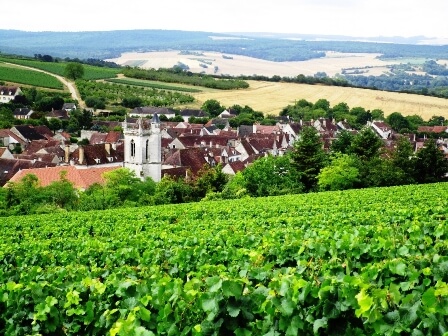
IRANCY
A walk inside the village is needed, mainly in the street that divides it in half from east to west. The houses are close together, without a court, and built on basements. Those who are grouped in front and a short distance from Town Hall Square offer provisions rather remarkable architectural style home of early 16th century. All moments of a prestigious past arise at every step. Here, a sundial, a rebus on the owner's name, carved in stone above the front door and there, various signs of companionship, mullioned windows, facades, gables, pottery shaded, turrets, elsewhere currency Templar? To do well, fear nothing?. This beautiful village is the home of the famous architect Soufflot, born in 1714 and died in Paris in 1781 (to which we must build the Pantheon).
The church is diverse, combining elements of the late 12th century to 18th century. It consists of three bodies, incompletely finished, they correspond to different times.
The walls of the 16th century were destroyed after the Revolution and the ditches filled and replaced by avenues of trees planted.
However, do not forget the most important. Make a visit to vineyards in the cool cellars, they will be pleased to discover an uncommon name, limited, but enjoys a certain notoriety, the Irancy.
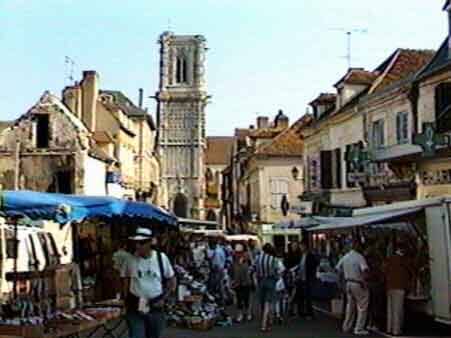
CLAMECY
Clamecy is located on a rocky outcrop north of (Burgundy), at the confluence of the Yonne and the Beuvron. It is crossed by the Canal du Nivernais.
The origin of Clamecy, which is mentioned in 635, is obscure. Clamecy has been variously designated:
* Urbs clementii, named Clementius, a Roman general.
* Clementiacum, named after a temple dedicated to the clemency which may have been high and that there remains no trace.
* Clemeciacum.
* Clamiciacum.
Built in the 8th century church, Clamecy is, in the early 11th century, the bishop of Auxerre, under the sovereign authority of the Counts of Nevers. They then built a castle there, now gone, surrounded by fortifications. Clamecy obtained his freedom from Hervé, Count of Nevers, in 1213. Clamecy weapons were those of the Landry family, former lords of Auxerre and Nevers.
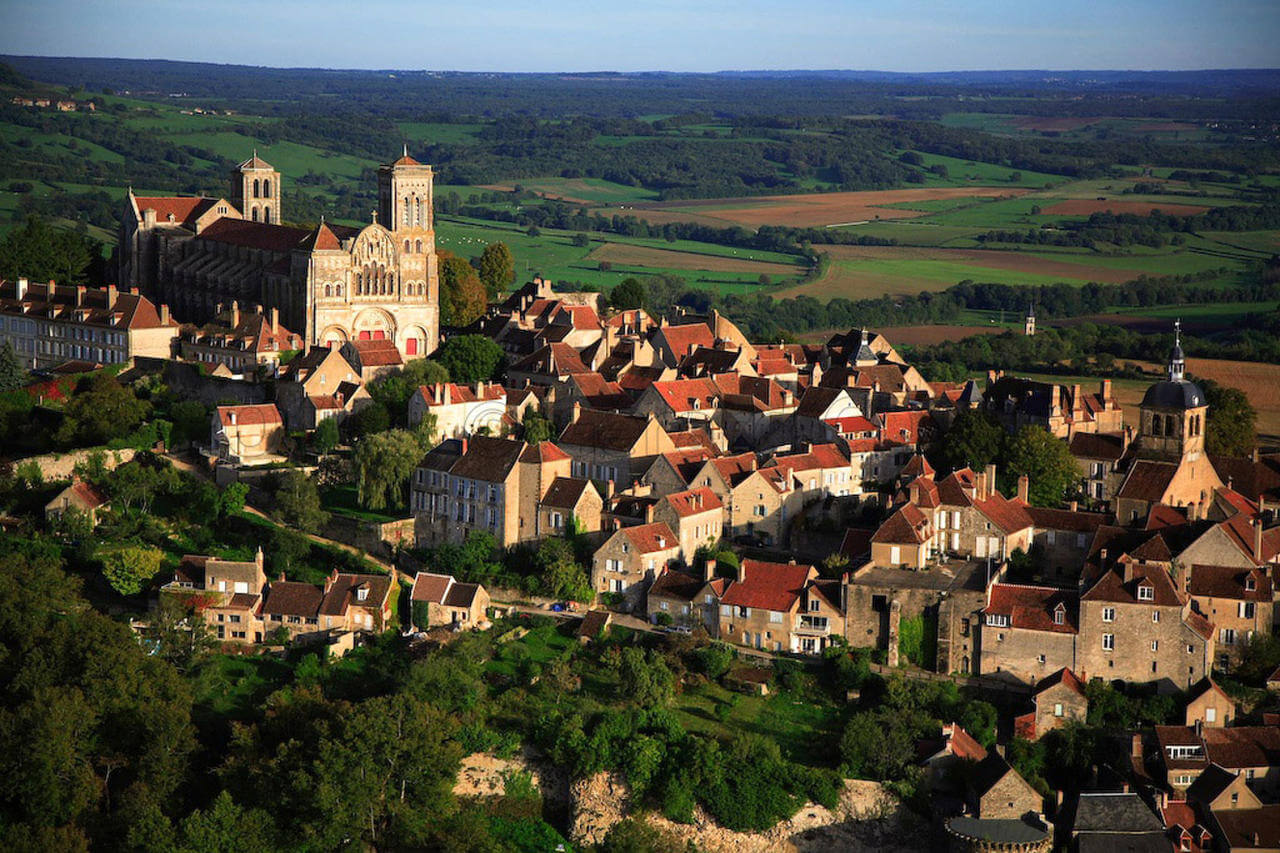
VÉZELAY
Vézelay is a center of Christianity since the Middle Ages, it is also a rallying point of the pilgrimage to St Jacques de Compostela. The Basilica Sainte-Madeleine and the village are classified as World Heritage by UNESCO. Vézelay is part of the "Most Beautiful Villages of France".
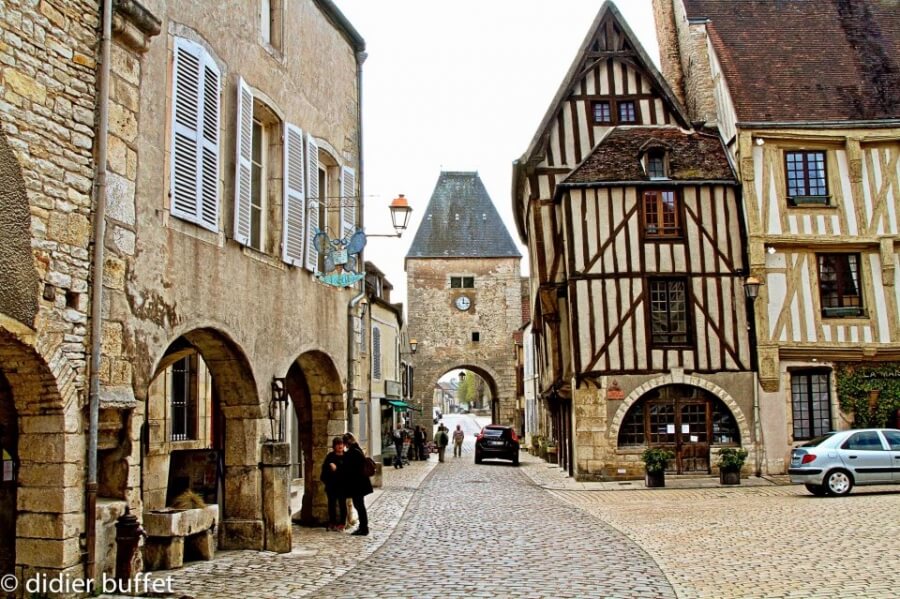
NOYERS-SUR-SEREIN
This listed medieval village is really delightful! The narrow paved streets of Noyers are lined with old timber-framed houses. The walk along the river of Serein is charming.
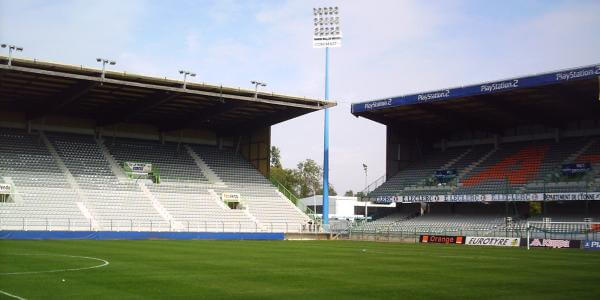
STADIUM OF L'ABBÉ-DESCHAMPS
The Stade Abbé-Deschamps is the home of AJ Auxerre football club in Auxerre, France. It has a capacity of 24,493. The stadium is the only Ligue 1 team stadium owned by the team. Renovated in 1994, it was renamed the Stade Abbé-Deschamps after Abbé Deschamps, who founded the club in 1905.

AUXERRE THEATRE
The city theater is managed by public service delegation by Aida association.
This agreement with scene offers each season a selection of various shows where successive theater, music, dance, circus and young audiences.
The season 2016 proposes offer its audience a forty shows calendar composed of a learned dosage of theater, dance, music and children's shows.

AUXERREEXPO
Convention center, exhibition center, theater, Auxerrexpo aims to be a key tool for economic development and animation of the Auxerrois, the Yonne, but also of Burgundy.
Auxerrexpo has all the advantages of a modern and functional tool.
Modular meeting rooms and can accommodate 10 000 people. On site, there are also the organizers offices, local catering, bar and restaurant. Note that parking lots occupy 18 000 m2
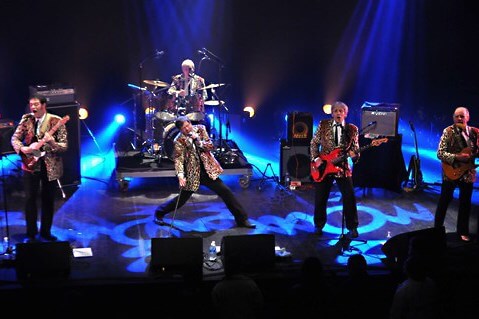
LE SILEX
Le Silex is the scene of contemporary music of the city of Auxerre in the department of Yonne and the region Bourgogne. Located close to the city center of Auxerre in the neighborhood Right bank, the concert hall is named for its architecture, its triangular openings, the colors of exterior materials and near an ancient archaeological dig.
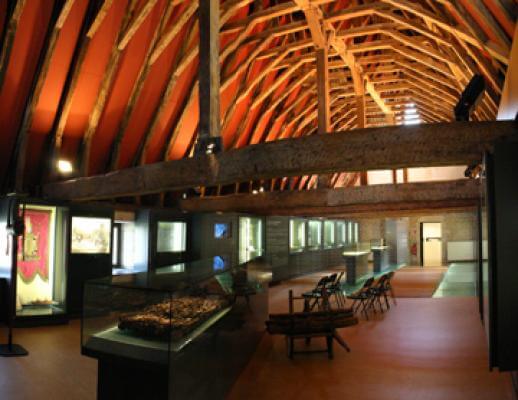
CLAMECY MUSEUM OF ART & HISTORY
The Clamecy Museum has been entirely renovated since 2005 and has very varied collections, shown off within a well-suited setting. It occupies the former mansion of the Duke de Bellegarde, the house where Romain Roland was born, which belonged to his grandfather, and a modern extension where the visitor enters. Here can be seen contemporary pictures given to President François Mitterrand;Gallic-Roman and Merovingian archeology; paintings and sculpture from the 16th to 21st centuries; an exceptional collection of Charles Loupot posters; old faience; souvenirs of Romain Rolland, and an evocation of floating wood down rivers.
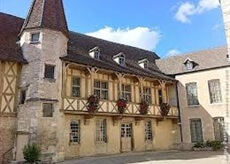
BEAUNE MUSEUM OF WINE
The collections of the Burgundy Wine Museum evoke the history of the vine from Antiquity until the 20th century. The winegrower's work is shown, thanks to the work of Georges-Henri Rivière, in which man is always at the centre.
The visit ends with the "Ambassadors' Room". It takes its name from a fraternity, which after the war sought to publicise the wine of Burgundy further. It is decorated with a tapestry by Lurçat, ordered for the place in 1947.
The fermenting room, whose structure goes back to the 14th century, houses a large number of presses from the 16th to 19th century.
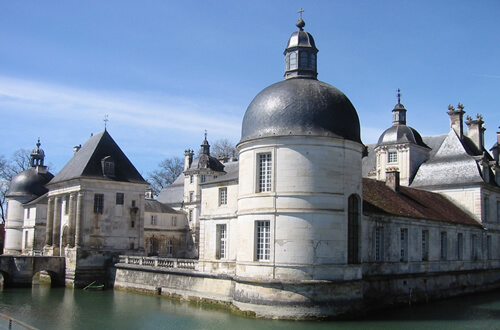
CHÂTEAU DE TANLAY
The castle of Tanlay is representative of the style Renaissance French, built in the 16th century and 17th century , surrounded by a moat . Some architectural details, such as the pyramids on the access bridge, the wall surrounding the Green Court, Gallery of the Caesars, the Nymph, are imbued with the Italian taste.
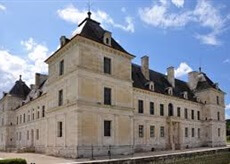
CHÂTEAU D'ANCY-LE-FRANC
The Château d'Ancy-le-Franc, designed by Sebastiano Serlio and constructed 1544-1550, is one of the sites where the Italian Renaissance was introduced, full-blown, to France. The patron was Antoine de Clermont, comte de Tonnerre, the brother-in-law of Diane de Poitiers and a courtier of François I.
The site in the canton of Ancy-le-Franc near Tonnerre in Burgundy he inherited from his mother. He demolished the old château-fort and used some of its foundations. The new structure was symmetrical: four ranges enclose a central court, and at each corner a pavilion was erected. Though it was never expected to be defensible, French tradition ran so strong that it was surrounded by a moat.
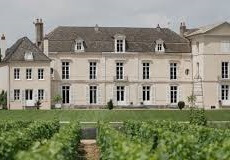
CHâTEAU DE MEURSAULT
An elegant building made of white stone, the Château de Meursault is one of the most visited estates in the Côte d’Or. It welcomes around 20 000 visitors per year who come to taste and buy the wine. The cellars, which lie under the Chateau and its outbuildings, some were dug out by the Monks of Cîteaux, can contain up to 700 000 bottles and more than 2 000 barrels.
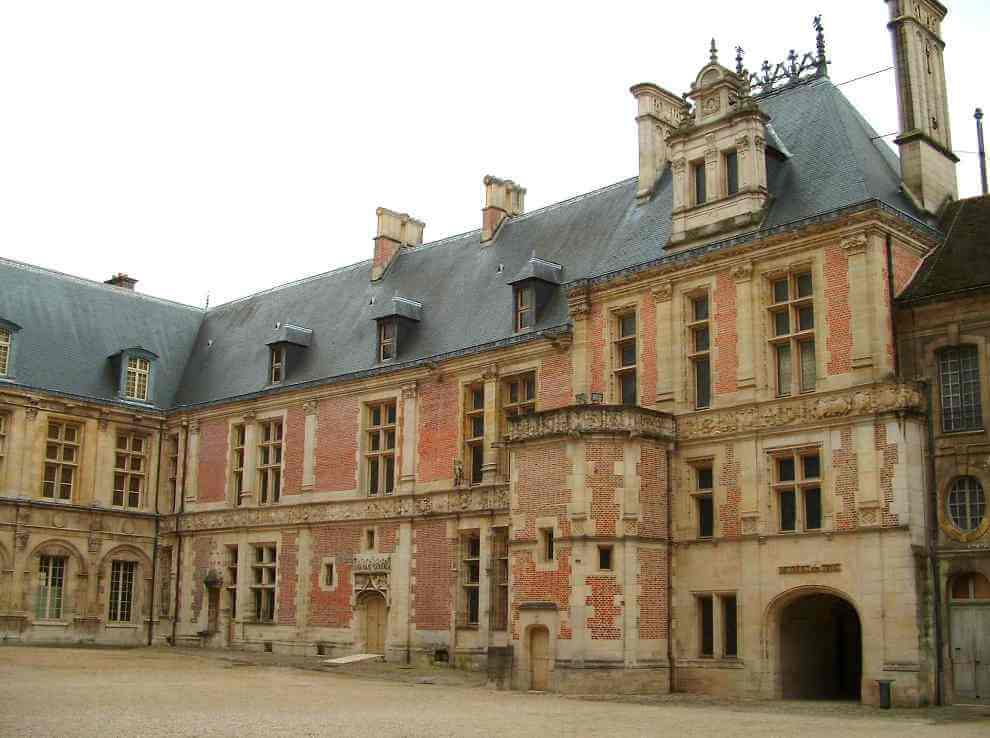
PALAIS SYNODAL DE SENS
This 13th century palace has an exceptional roof of Burgundian glazed tiles restored by the 19th century architectural purist Viollet-le-Duc, as were those of so many other buildings in this region. Its vaulted halls, originally designed to accommodate the ecclesiastical courts, now house the excellent Musée de Sens which makes good use of all available space to display a marvellous collection of exhibits found in the region. The collection includes statues from the cathedral and Gallo-Roman mosaics. Prize exhibits include the Villethierry treasure which consists of 867 items of bronze jewellery found in a jar, thought to be a jeweller’s hoard. It has a collection of bone combs and the facade of Sens’ second-century public baths.
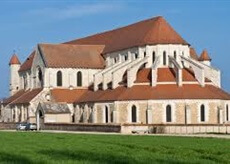
ABBAYE DE PONTIGNY
Located 17 miles north of Auxerre on the banks of the Serein, Abbey of Pontigny is one of the oldest Cistercian monasteries and abbey church is, with its 120m long, the largest Cistercian church in Europe. It is now owned by the Regional Council of Burgundy, but its development and animation of this heritage are provided by the Association of “Les Amis de Pontigny” organizing site visits, conferences, exhibitions, and concerts of sacred music.
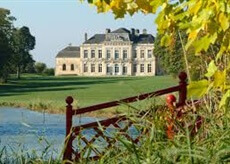
CHÂTEAU D’ARCELOT
12 km from Dijon, the Château d’Arcelot is the first example of a château in the neoclassical style to be built in Burgundy. It was designed by architect Dumorey, who built the castle as it stands today between 1761 and 1765, adding to the initial buildings which date back to the beginning of the 18th Century. Unique due to its beautifully-crafted Grand Salon and its magnificent English-style gardens, designed by Morel in 1805, the Château d’Arcelot offers guided tours. Rates are €6 per adult, €2 to visit the gardens only.
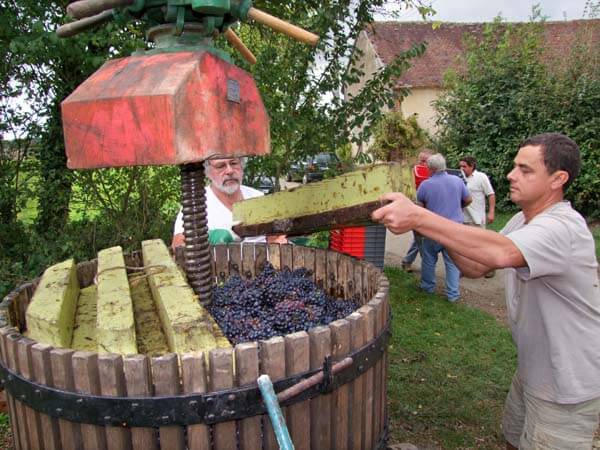
JOIGNY VINEYARD
The first Burgundian vineyard on the route from Paris, it takes over the Côte Saint-Jacques that overlooks the town and a few hectares in Volgré and Champvallon. It traditionally produces the Côte-Saint-Jacques red and rosé Burgundy wines, whose reputation goes back hundreds of years, and, for a just a few decades, a much-appreciated white Burgundy.
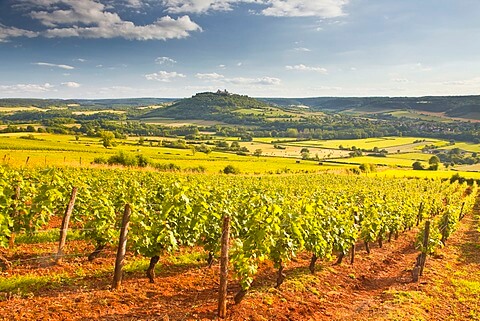
VÉZELAY VINEYARD
In Vézelay, on the slopes of the Eternal Hill, and the lovely neighbouring villages of Saint-Père, Tharoiseau and Asquins, this celebrated vineyard, which dates from the Middle Ages, produces an excellent, extremely varietal white Burgundy-Vézelay made from Chardonnay, plus an interesting red Burgundy, and for those with a taste for discovery, a Bourgogne Grand-Ordinaire made from Melon de Bourgogne or de l'Auxerrois, old Burgundy grape varieties that have almost entirely.
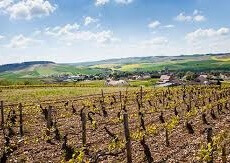
AUXERROIS REGION VINEYARDS
From Auxerre, whose once-glorious vineyard outshone that of Beaune (now only 4 of the 6-hectare Clos de la Chaînette, a Burgundy appellation, now remain), the wine route crosses the winemaking villages on the Yonne’s left bank of Jussy and Escolives-Sainte-Camille, where you must not miss a visit to the Gallo-Roman site or small Roman church, and Migé with its windmill. Here, the Pinot Noir produces a remarkable red Burgundy, the Bourgogne-Coulanges with its red fruit aromas.
Then, before crossing the Yonne over to Cravant, the route enters Palotte Hill, the best vineyard, on the Irancy territoire, a winemaking village dotted with old houses, including the house where Jacques Germain Soufflot, the architect of the Pantheon, was born in 1710, wonderfully set at the bottom of a horseshoe hill surrounded by vines and cherry trees. In Irancy and across a few hectares of the neighbouring villages of Cravant and Vincelottes, 150 hectares of Pinot Noir and a few hectares of the rare Cesar variety, an ancient grape that may well go back to the Gallo-Roman
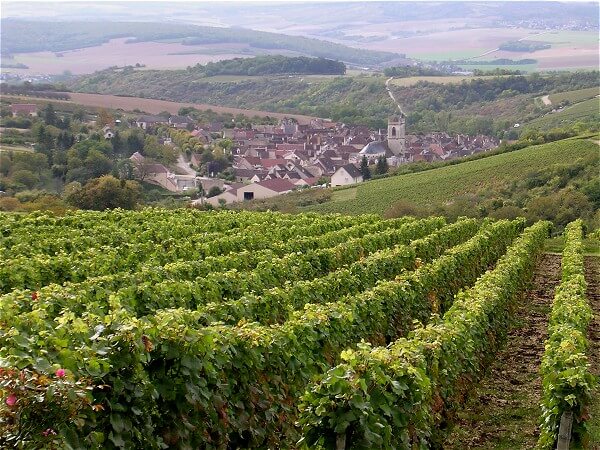
CHABLIS VINEYARDS
Here you can explore the vineyard of Chablis, the biggest Blanc de Bourgogne vineyard that spreads across 4,300 hectares planted exclusively with Chardonnay, producing wines celebrated the world over: the Petit Chablis produced on the top of the hills, to drink young, Chablis, Premiers Crus Chablis and the greeny-gold Grands Crus Chablis that are in a class of their own.
Past Préhy and its church standing alone in the middle of vines, the road descends on the Serein, giving wonderful views over the Montmains and Butteaux premiers crus before arriving at the small town of Chablis. In the background, the seven grands crus: Blanchot, Les Clos, Valmur, Grenouille, Vaudésirs, Preuses and Bougros huddle on their hillside surrounded by the hills covered with the premiers crus of Montée-de-Tonnerre and Mont-de-Milieu to the right, Fourchaume and Homme-Mort to the left.
After a trip around Chablis and its beautiful 13th-century Saint-Martin Church, you can take a path through some of the most splendid vineyards before leaving the Serein Valley, climbing the plains.
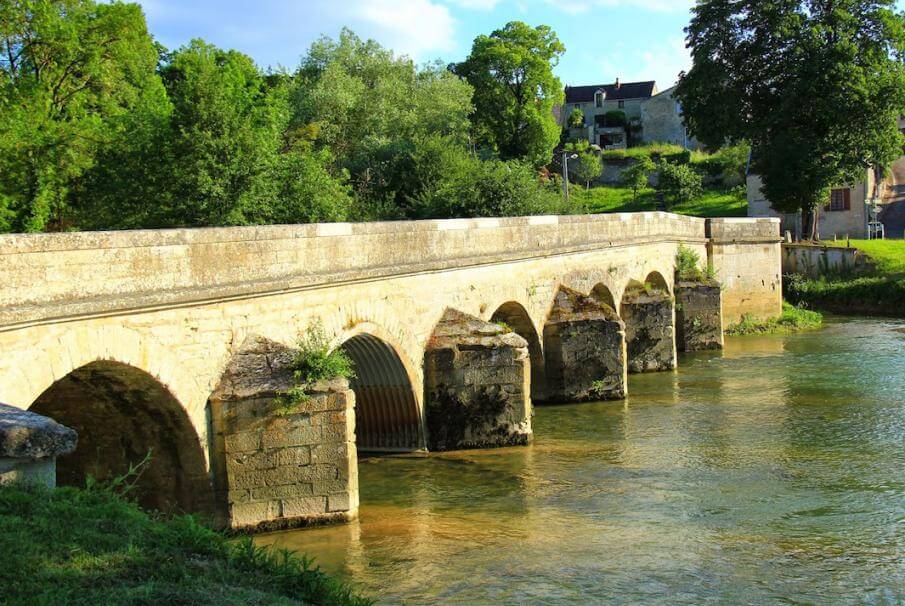
TONNEROIS VINEYARDS
The wine route crosses Tonnerre, once home of the Knight of Eon, with its outstanding 13th century general hospital and amazing Fosse Dionne, the Vaucluse source, then presses on to Molosmes, an old village lost in the surrounding sloping hills. Tonnerre and Molosmes produce principally a white Burgundy and, from just recently, the white Bourgogne-Tonnerre appellation while in Epineuil, the next and final leg, Pinot Noir dominates with the Bourgogne-Epineuil, a wine filled with sap and very particular aromas specific to the land. On a few hills only, those of Grisées in particular, Chardonnay produces a white Burgundy that is on a par with Chablis. And at end the day, take a trip to Epineuil’s church to see its wonderful furniture and the birthplace of Alfred.
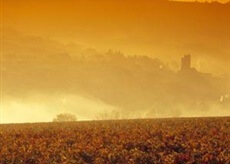
IRANCY VINEYARDS
Irancy is a village in the north-western corner of the Burgundy, France, just a short distance to the west of Chablis. Its Irancy appellation was created in 1999, specifically for red wines made from Pinot Noir, with a permitted 10% addition of Cesar.
In addition to Irancy itself, the title is also available to wines from the neighboring villages of Cravant and Vincelottes (both of which also produce white, Sauvignon-based wines under the Saint-Bris title).
Located a latitude of almost 48°N, Irancy is one of France's most northerly red-wine appellations. Although Champagne, 100 miles to the north, grows a significant quantity of Pinot Noir grapes, these are used in sparkling white wines, whose style depends on a certain level of under-ripeness. Alsace is also a little further north than Irancy, but Alsace is hardly a region famed for its red wines, and has no red-specific appellations.
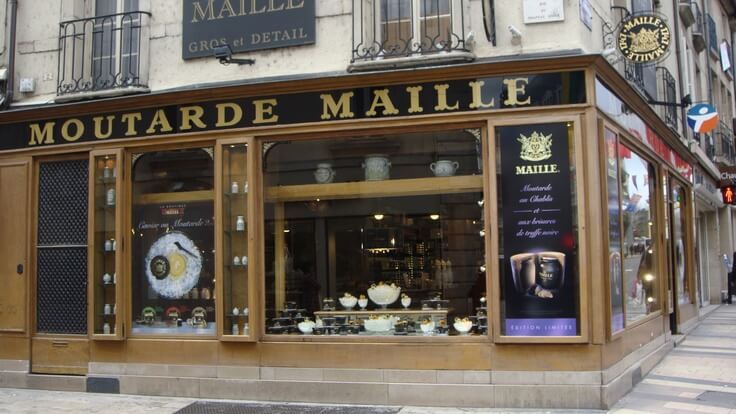
DIJON
Welcome to Dijon, capital of the Dukes of Burgundy!
Guided tours, Segway, Museums, Shopping and more...
With the Dijon City Card, you'll enjoy special privileges to access the main monuments and attractions of our beautiful city where heritage, culture and cuisine come together perfectly. Explore Dijon and its secrets, freely and at your own pace!
Didn't get to see everything during your stay?
Don't hesitate to come back to Dijon; your City Card is valid for a whole year! Access to Dijon is easy via train only 40mins ride from our local train station or an easy drive through the stunning Burgundy countryside
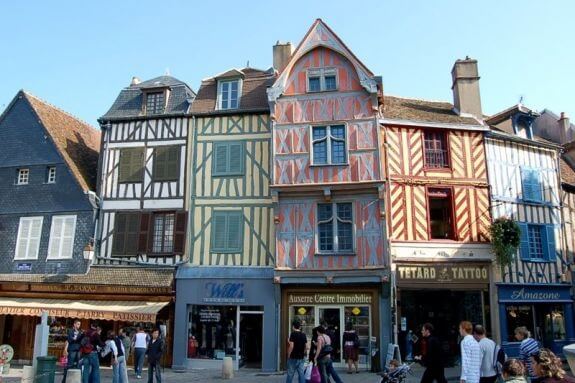
AUXERRE
Situated on the River Yonne, Auxerre is a very pleasant town with an unhurried air about it. The town originally became prosperous as an active port on the wine route. Then the railway superseded river transport and it turned into a trade backwater. Now holiday cruisers and hotel barges bring the river to life making it one of the focal points of the town. Stroll along the leafy boulevard on the bank and people-watch from the terraces of the cafes and restaurants.
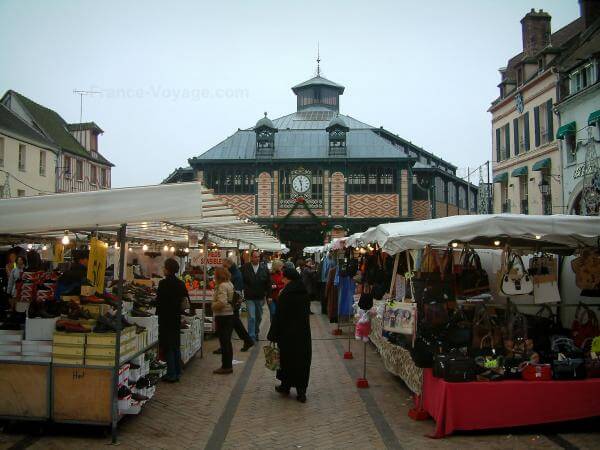
SENS
The countryside around Sens is known as Burgundy’s granary: cereals and orchards predominate. The town grew up on the River Yonne, and with the Cathedral St-Etienne at its centre, it became an important ecclesiastical entity. Sens is small and easily accessible, with the main points of interest radiating out from the cathedral. Enjoy the cafes in the Place de la République around the cathedral, the half-timbered houses and classy shops along the pedestrian walkway Grande Rue. There is an excellent cheese shop at 1 Vieilles Etuves called Parret, selling wines to accompany your choice.
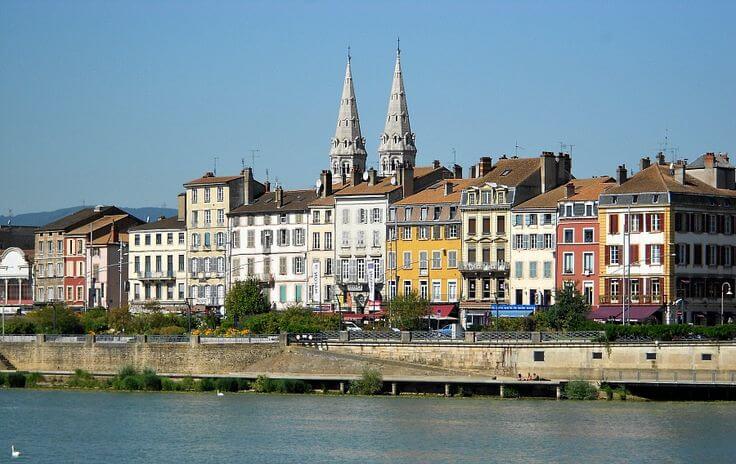
MÂCON
Buildings painted burnt sienna, buttermilk and rose – MÂcon has a distinctly Mediterranean feel and looks to the south for inspiration. To get a feel of this town on the River Saône, head for the terrace of the café in the Maison de Bois, a house covered in elaborate, if not grotesque, wooden carvings normally reserved for interiors. There you can people watch: it is on the corner of Rue Dombey and Place aux Herbes where the vegetable market is held daily with the exception of Monday.
Rue Carnot is one of the busiest shopping streets in the town. Here, is the L’Ancien Hospice de la Charité, once a hospital, but now an old people’s home. To the right of the front door is a swivel-gate where new-born babies were abandoned by placing them unseen in a barrel which then swivelled around and when the bell was rung, the nuns rushed to collect the baby. A walk around the town on the Heritage Trail brings you to the Hôtel Dieu, the Old St.Vincent Hospital.
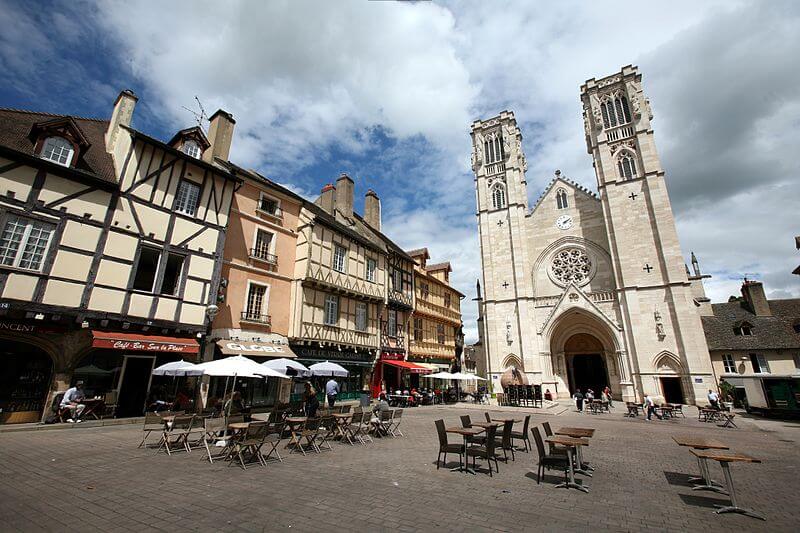
CHALON-SUR-SAôNE
Nuits and Côte de Beaune in the north and the Mâconnais in the south. Famous wines such as Mercurey, Givry, Montagny and Rully come from here. Visit the Maison des Vins de la Côte Chalonnaise at 2 Promenade Ste-Marie to sample these fine wines.
This is a lively town on the River Saône with a market three times a week at the Place St-Vincent. The cathedral square has a café society with Le Moulin à Cafe and speciality shops such as Légendes Gourmandes. There are fine half-timbered houses overlooking the Place; Rue de Châtelet and Grande Rue are worth visiting also to see 17th and 14th century facades. The cathedral itself is a good example of Romanesque architecture.
If you are interested in photography, Joseph Nicéphore-Niépce who invented the first photograph was born in Chalon in 1765. A museum dedicated to him is housed in the Hôtel des Messageries on the banks of the Saône. Apart from cameras, it has a fine photographic collection on display tracing the history of photography. Along the Quai, the Atelier St-Jean there is an art gallery with exhibitions by prominent artists.
The bakery, La Meulière, in Rue Général Leclerc is a particular favourite for whole cereal breads, biscuits, jams and cheesy wafers for apéros.
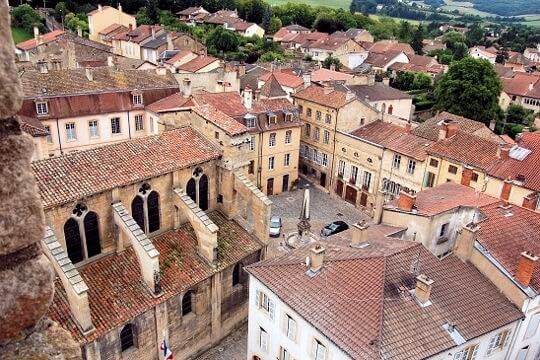
CLUNY
It's easy to see why artists and artisans, poets and writers are attracted to the countryside around the town of Cluny which is dotted with little Romanesque churches, picturesque villages and river valleys. It is a gentle and unhurried pace as it was all those years ago when a handful of monks chose to set up the monastery in the Grosne valley. The peaches and cream walls of the old buildings, with their coloured shutters, give the town a Mediterranean touch.
The monastery of Cluny was once the greatest power in Europe, controlling over 10,000 monks from Poland to Scotland. The abbey today is a ghost of the past - only one tenth of the gigantic cathedral remains. This was the first monastery in Burgundy, started by the Benedictine monks in 910AD. Over 1000 monks were in residence, large buildings had to be erected to house everyone and 40 farms produced the food.
The town of Cluny has grown up around the remains of the Abbey. The Hotel de Bourgogne has been built right on top of the abbey in fact and you can visit some of the 18th century cellars by wine tasting at Le Cellier del’Abbaye, best entered from Rue 11 Août 1944. Rue Lamartine has attractive shops, including the chocolate maker Germain, and there are plenty of little restaurants with terraces to soak up the atmosphere.
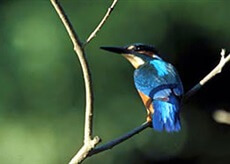
BIRD WATCHING
There are some 160 species of birds in the Doubs Valley near Chalon-sur-Saône. Nature photographer Frédéric Tillier who captures many of his fantastic images in the wild here suggests spots where you can sight bee-eaters and black kites, kestrels and honey buzzards...
The river Doubs rises in the Jura mountains and flows into the river Saône at Verdun-sur-Doubs. As it reaches Burgundy, the lower Doubs as it is known, has broad meanders and wooded banks, limestone cliffs, beds of gravel and little islands. It is nature’s paradise – in the river and its surroundings there are 42 different mammals, 30 species of fish, 160 of birds and 600 of plants. With the migrating birds returning from their winter exile, you could well be in Africa itself; there are many similarities both in the birds and the habitat.
Rich in birdlife it certainly is. In 1992, the area was granted special protection by Le Patrimoine Naturel de Bourgogne and birdwatchers have recorded sighting nearly 100 species of birds in a couple of days here. The area is well signed but of course you must take immense care not to disturb the wildlife, particularly avoiding the sites at nesting time.
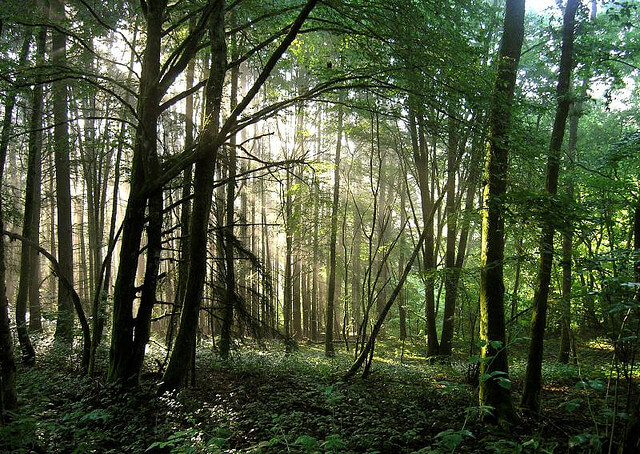
MORVAN FOREST
Burgundy is a paradise for the nature lover. The jewel in the crown, sitting in the centre of Bourgogne is the Morvan Forest, a natural park covering nearly a quarter of a million hectares. This is a granite outcrop in the middle of a mainly limestone region. There are deep valleys and faults crossed by rapids, peaks covered with forest and mountainsides dotted with bogs and broom-covered heaths. The rivers Yonne, Cousin and Cure weave their way through the region forming some of the most picturesque valleys imaginable with wild cowslips and violets in profusion in spring. There are numerous tributaries and smaller rivers, waterfalls, lakes and reservoirs.
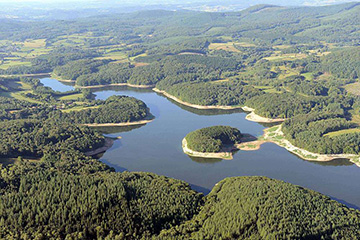
MORVAN NATIONAL PARK
Morvan Regional Natural Park is a protected area of woodlands, lakes and traditional farmland in the Burgundy region of central France. It covers a total area of 173,000 hectares and extends through four different departments with the majority being in Niìvre. The area was officially designated as a regional natural park in 1970. There are endless activities to take part in within the park itself.
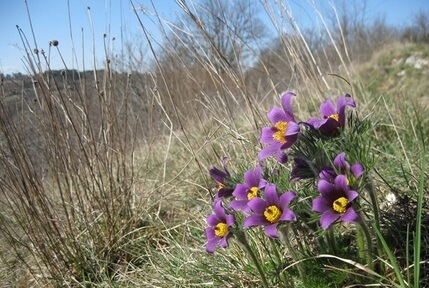
BIOS DU PARC, MAILLY DE CHÂTEAU
Visit the woods of the Park Reserve to make amazing discoveries. Major geological site, the quarry at the foot of the Cliff reveals ancient corals, colonial settlements. The top of the cliffs and plateau welcome you onto lawns, bushes and forests of oak and other charms, rich in plant species observed usually much more South.
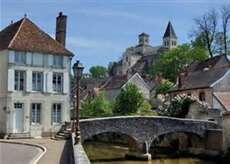
CHÂTILLON-SUR-SEINE
On the banks of the Seine stands Châtillon-sur-Seine, centre of the Pays Châtillonnais. This town, which holds a France in bloom award and a 'Plus beaux détours de France' label, will soon be part of a National nature park. A chance to enjoy the benefits of nature conservation... To the south, between Alésia and Saint-Seine-l'Abbaye, are the remains of a temple to the Goddess Sequana in the unspoilt setting of the Source of the river Seine. At Bèze you can explore the second largest underwater river system in France. Visitors start off on foot before boarding a boat to visit the caves. Less than 100 km away, at Nolay, below the vineyards, flows the cascade du bout du monde. The clear waters of this waterfall cascade down 25 metres of limestone cliffs.
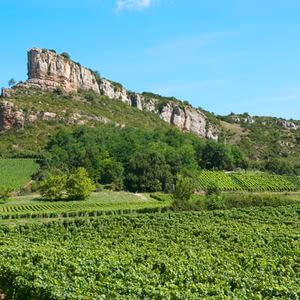
HAUT-FOLIN
In the Saint-Prix area the Haut-Folin is the highest point of the Morvan. On a clear day you can see as far as the Mont Blanc! A 14 km north-west of Le Creusot, admire the granite blockfields in the village of Uchon, with their legendary 'rocking boulder' and 'devil's claw'. Then you can visit the Blanot caves on the western side of Mont St Romain. It takes an hour to tour the immense limestone galleries up to 80 metres below ground! Your final feat is to climb the 492 metres of the Solutré rock - well worth it for the panoramic view of vineyards dotted with villages and surrounded by forests...
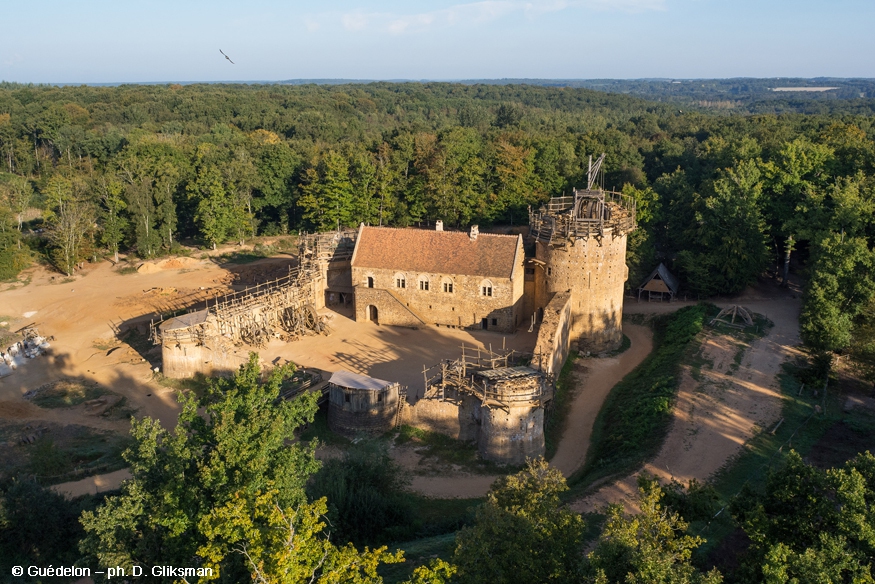
GUÉDELON
the 21st-century medieval adventure
In the heart of France, in northern Burgundy, a team of fifty master-builders have taken on an extraordinary challenge:
building a castle using medieval techniques and materials.
OUR CAMPING IMAGES



